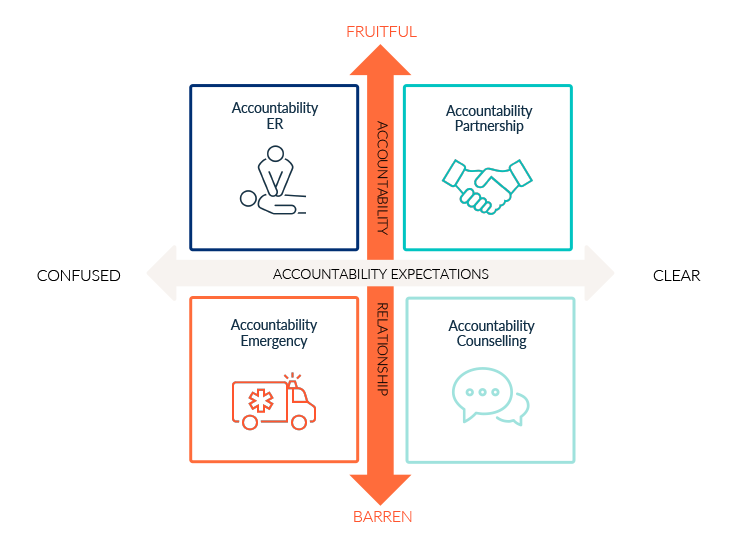Can You Diagnose the Problem?
It can be hard to know where to begin.
You know that issues with accountability are limiting progress and enabling underperformance. You see that it’s making the team fragile as you navigate the uncertainty and disruption of a COVID-impacted world of work. But you’re unsure how to move forward.
You’re experiencing what I see in my work with leaders across all sectors – that challenges with accountability prevent them, their teams and their organisations from reaching their full capacity, capability and impact.
Which is why I did a deep dive into the research to find out what supports effective, productive accountability. And the research suggests that it’s two factors:
- The Quality of Accountability Relationships
- The Clarity of Accountability Expectations
I wrote about the quality of Accountability Relationships in this blog recently, and about clarity of Accountability Expectations here. Understanding how the two factors interact can help us diagnose the cause of accountability issues and recognize how we might address them.
Let’s use a 2×2 matrix to understand how these drivers of accountability interact and create different scenarios that impact performance.
The vertical axis in the diagram below shows the quality of accountability relationships, ranging from Barren to Fruitful and the horizontal axis, clarity of accountability expectations, from Confused to Clear.

 Confused Expectations + Barren Relationship = ACCOUNTABILITY EMERGENCY
Confused Expectations + Barren Relationship = ACCOUNTABILITY EMERGENCY
When accountability expectations are confused and the relationship is barren, there is little possibility that people will reach out for the help or support that could improve the situation by asking for information about what is needed from them and how they might achieve it. The lack of safety in the relationship means that the focus is inwards, on staying safe and playing small.
This is a black hole for accountability and a pit for progress and performance.
 Confused Expectations + Fruitful Relationship = ACCOUNTABILITY ER
Confused Expectations + Fruitful Relationship = ACCOUNTABILITY ER
Whilst the accountability relationship is fruitful confused expectations mean that there is under-performance. The good news is that relationship is productive, so with the right conversations, clarity can improve. The risk lies in returning to an Accountability Emergency if the confusion continues, causing frustration that negatively impacts the quality of relationship.
So, whilst progress is being limited here, much like a patient in the ER, the situation can be saved given the right treatment.
 Clear Expectations + Barren Relationship = ACCOUNTABILITY COUNSELLING
Clear Expectations + Barren Relationship = ACCOUNTABILITY COUNSELLING
There is a fragility to the situation when accountability expectations are clear but the relationship is barren that may be tested when problems arise. As we know, life rarely goes according to plan, and it is at these times that the quality of the accountability relationship makes a difference. The trust and psychological safety that are present in fruitful relationships support honest conversations about potential challenges and issues before they develop and enable collective problem solving to resolve them.
There is performance and progress potential here if the relationship can be nurtured and developed.
 Clear Expectations + Fruitful Relationship = ACCOUNTABILITY PARTNERSHIP
Clear Expectations + Fruitful Relationship = ACCOUNTABILITY PARTNERSHIP
When accountability relationships are fruitful and expectations are clear a true Accountability Partnership exists. In this situation, people can question expectations, ask for support to fulfil them if needed and feel confident in flagging issues as they arise along the way. Reviews and progress check-ins are agreed, regular and transparent, and people take personal ownership for their accountability expectations. The focus is outwards, with a mindset of contribution and an understanding that ‘what I do matters to the progress that we make together’.
This is where peak progress and performance lives.
Using The Accountability Reset Matrix
The Accountability Reset Matrix can help us become clearer on the cause of our current accountability challenges and help identify the action we can take to support peak performance and progress – for ourselves and others. Our goal is to move our current challenge closer towards an Accountability Partnership.
Here’s how to use the Matrix:
Consider your most pressing accountability challenge right now. It may be that you are being asked to be accountable for something (you are the Accountee) or you are asking someone to be accountable (you are the Accountor).
1. Where would you place this situation on the matrix in terms of quality of accountability relationship and clarity of accountability expectations?
What Accountability Scenario is this current challenge in? Emergency? ER? Counselling?
2. Which of the two factors does this suggest would help move this situation towards an Accountability Partnership?
3. What is the conversation that would support this positive shift? Who is it with? What questions would you need to ask?
It’s also important to remember that yours is only one perspective of this accountability challenge. A powerful way I’ve found to begin Accountability Reset conversations like this is to ask where the other person would place the current situation on the matrix. Understanding your different perspectives is a great way to open up conversations about how to get things back on track.
After all, as leadership writer and researcher Margaret Wheatley so wisely says, Change starts with a conversation.
Want more?
You can read more about how leaders can take a more effective approach to accountability in the e-book I’ve written based on my research, The Accountability Reset. Just click here to download it.
Time to talk?
If you’d like to talk about how we can work together to help you, your leadership team or your organisation reduce fragility by resetting accountability. Simply click here and I’ll be in touch.

Dr Paige Williams
International Speaker, Author, Mentor
Determined to help leaders move beyond just the need for resilience, Paige provides practical, evidence-based strategies for leaders to become antifragile, lead themselves and their teams to thrive and succeed in the Decade of Disruption.





